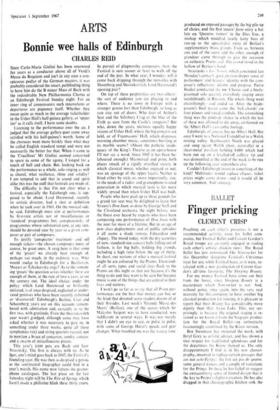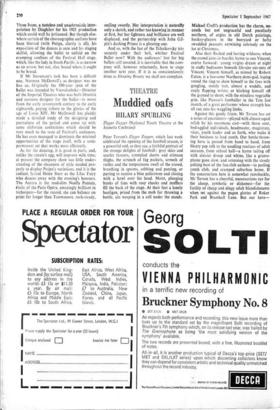Finger pricking
BALLET CLEMENT CRISP
Poaching on each other's preserves is not a recommended activity, even for ballet com- panies, but Festival Ballet and Covent Garden's Royal troupe are currently engaged in raiding each other's artistic chicken runs: The Royal Ballet has just announced The Nutcracker for this December (longtime Festival's Christmas treat for us), while Festival have, as it were, re- taliated with a new production of Covent Gar- den's all-time favourite, The Sleeping Beauty.
For my money Festival have come out best from the foray, since Sleeping Beauty is a masterpiece which Nutcracker is not. And, without going, once again, into the very real necessity for this company to have another big classical production for touring, it is pleasant to report that their Beauty has considerably more dignity than their Swan Lake. This, not sur- prisingly, is because the original staging is re- tained as we know it from the Sergcyev produc- tion for the Royal Ballet—an authenticity fascinatingly confirmed by the Kirov version.
Ben Stevenson has mounted the work, with Beryl Grey as artistic adviser, and has shown a nice respect for traditional splendours and for the departures the Kirov showed us. The only disappointment I find is in his new choreo- graphy, invented to replace certain passages that are not echt-Petipa : the last act pas de quatre, some general dances and a couple of variations for the Prince. In these he has failed to suggest the extraordinary sense of formal design that is the key to Petipa's slightest creation. He has also dragged in that choreographic kitchen sink, the Three !vans, a tasteless and anachronistic inter- polation by Diaghilev for his 1921 production which could well be jettisoned. But though else- where certain of the choreographic outlines have been blurred (with Petipa, clarity is all), his exposition of the dances is sure and his staging skilful, allowing the ballet to unfold on the cramping confines of the Festival Hall stage, which, like the lady in South Pacific, is as narrow as an arrow, but not, alas, broad where it ought to be broad.
If Mr Stevenson's task has been a difficult one, Norman McDowell's as designer was no less so. Originally the 100-year span of the ballet was intended by Vsevolozhsky—Director of the Imperial Theatres who was both librettist and costume designer for the ballet—to move from the early seventeenth century to the early eighteenth, paying tribute to the glories of the age of Louis XIV. Mr McDowell has plainly made a detailed study of the designing and portraiture of the period and come up with some elaborate confections which should be very much to the taste of Festival's audiences. He has even managed to dominate the minimal opportunities of the stage itself, with a semi- permanent set that works most efficiently.
As for the dancing, it is good in parts, and, unlike the curate's egg, will improve with time; at present the company show too little under- standing of the cleanness of style needed pro- perly to display Petipa's variations, and it is the radiant, lyrical Helen Starr as the Lilac Fairy who dances away with the evening's honours. The Aurora is the reed-slim Noella Pontois, itoile of the Paris Opera, amazingly brilliant in techniques—for the record, she can balance on point for longer than Toumanova, rock-steady, smiling sweetly. Her interpretation is naturally only a sketch, and rather too knowing in manner at first, but her lightness and brilliance are well displayed, and the partnership with John Gil- pin's dashing Prince is a pleasing one.
And so, with the last of the Tchaikovsky trio securely under their belt, whither Festival Ballet now? With the audiences' lust for big ballets still unsated, it is inevitable that the com- pany will, however reluctantly, have to stage another next year. If it is as conscientiously done as Sleeping Beauty we shall not complain.































 Previous page
Previous page